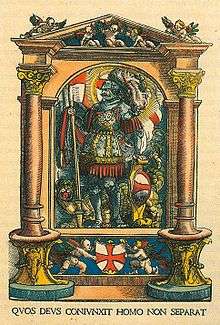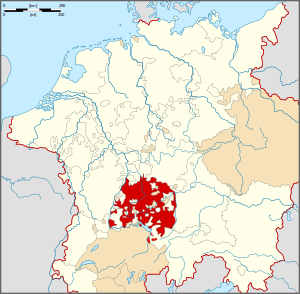Isny im Allgäu
| Isny im Allgäu | ||
|---|---|---|
 | ||
| ||
 Isny im Allgäu | ||
Location of Isny im Allgäu within Ravensburg district 
 | ||
| Coordinates: 47°41′31″N 10°2′22″E / 47.69194°N 10.03944°ECoordinates: 47°41′31″N 10°2′22″E / 47.69194°N 10.03944°E | ||
| Country | Germany | |
| State | Baden-Württemberg | |
| Admin. region | Tübingen | |
| District | Ravensburg | |
| Government | ||
| • Mayor | Rainer Magenreuter (Ind.) | |
| Area | ||
| • Total | 85.37 km2 (32.96 sq mi) | |
| Population (2015-12-31)[1] | ||
| • Total | 13,602 | |
| • Density | 160/km2 (410/sq mi) | |
| Time zone | CET/CEST (UTC+1/+2) | |
| Postal codes | 88316 | |
| Dialling codes | 07562 | |
| Vehicle registration | RV | |
| Website | www.isny.de | |
Isny im Allgäu is a town in south-eastern Baden-Württemberg, Germany. It is part of the district of Ravensburg, in the western, Württembergish part of the Allgäu region.
Isny was a Free Imperial City (Freie Reichsstadt) until the mediatisation of 1803.
History



| Imperial City of Isny in the Allgäu | ||||||||||
| Reichsstadt Isny im Allgäu | ||||||||||
| Free Imperial City of the Holy Roman Empire | ||||||||||
| ||||||||||
| Capital | Isny im Allgäu | |||||||||
| Government | Republic | |||||||||
| Historical era | Early modern period | |||||||||
| • | Abbey founded by Count of Altshausen-Veringen | 1096 | ||||||||
| • | Isny gained town rights | 1235 1365 | ||||||||
| • | Became Imperial city by purchasing Vogtei from Stewards of Waldburg | 1365 | ||||||||
| • | Protestant Reformation | 1529 | ||||||||
| • | Abbey gained Imperialimmediacy | 1781 | ||||||||
| • | City mediatised and abbey secularised to Princely County of Quadt-Wykradt | 1803 | ||||||||
| • | City and abbey mediatised to Kgdm Württemberg | 1806 | ||||||||
| ||||||||||
During the three centuries following its origin in 1042, it was a commercial center controlled and exploited by various competing feudal lords. In the 13th century, Isny's merchants built a fortification system to protect the town from marauders and rival feudal rulers. The town is still partially surrounded by the city walls and moat that were built during these early turbulent times.
After three centuries of domination by feudal lords and territorial rulers, Isny's middle class was able to purchase the town's independence in 1365. Isny's status as an Imperial city made it a self-governing republic in which the city government was elected by propertied residents and in which the guild system thrived. In 1529, Isny's Protestant minority took the city council and voted to make the town Protestant and the Nikolaikirche became the town's main Protestant church. In 1803, the Kingdom of Württemberg allowed the Catholic majority to once again move to the city. In 1889, the majority of urban residents was Catholic (1139 ev / 1444 Cath.).
Isny enjoyed a vibrant economy, based primarily on linen production, until competition from abroad, the devastation of the Thirty Years' War, and a series of fires and plagues brought production to a halt in the 17th century. The town experienced a revival after the end of World War II, when a rehabilitation center for war veterans was established there. Fortunately, Isny emerged from the war largely undamaged, and has since become a popular destination for vacationers and resort-goers.
International relations
Isny im Allgäu is twinned with:
-
 Andrychów, Poland
Andrychów, Poland -
 Notre-Dame-de-Gravenchon, Seine-Maritime, France
Notre-Dame-de-Gravenchon, Seine-Maritime, France -
 Street, Somerset, United Kingdom
Street, Somerset, United Kingdom -
 Flawil, St Gallen, Switzerland
Flawil, St Gallen, Switzerland -
 Sotkamo, Oulu, Finland
Sotkamo, Oulu, Finland
Sons and daughters of the town
- 1835, November 26 Wilhelm von Waldburg-Zeil]], who was born in Neutrauchburg, † July 20, 1906 Schloss Zeil, politician, member of parliament
- 1839, April 1, Constantin von Waldburg-Zeil (politician) | Constantin von Waldburg-Zeil]], who was born in Neutrauchburg, † March 25, 1905 in Merano, politician, member of parliament
- 1841, December 18,Karl Graf von Waldburg-Zeil, † January 30, 1890 on Castle Syrgenstein Explorer
- 1845, October 17, Franz Ehrle, † March 31, 1934 in Rome, Jesuit and Cardinal of the Roman Catholic Church
- 1865, October 5, Hubert Netzer, † 15 October 1939 sculptor and academy professor
- 1866, November 19, Jacob Binder]], † March 6, 1932, politician (SPD) MdR
- 1869, September 4, Eugen Felle, † 1934 postcard painter
- 1887, January 6, Eugene of Quadt to Wykradt and Isny]], † October 19, 1940 in Isny, politicians ( BVP) MdR, Bavarian economy Minister
- 1931, May 24, Ernst Mutschler, pharmacologist
- 1932, April 6, Günter Herburger, writer
- 1946, May 17, Hartmut Krebs, September 29th 2007, politician (SPD), secretary of state and entrepreneur
- 1948, February 28, Friedrich Hechelmann, painter
- 1948, Karl Immler, entrepreneur and philanthropist
- 1950, Jakob Immler, entrepreneur and philanthropist
- 1962, April 30, Roberto Capitoni, German-Italian comedian
- 1962, June 26,[Peter Rohwein, German champion in ski jumpers, former German ski coach
- 1968 January 4, Roland Pfaus, Actor
- 1969, June 17, Peter Rist, crooner
- 1976, Daniel Mark Eberhard, a music teacher and jazz musician.
- 1976 Manuel Ochsenreiter, journalist
- 1991, January 12, Robin Lässer, motorcycle racer and German Champion
References
External links
| Wikimedia Commons has media related to Isny im Allgäu. |
| Wikisource has original text related to this article: |
- Isny Tourist website (German)
- Photographs of Isny



